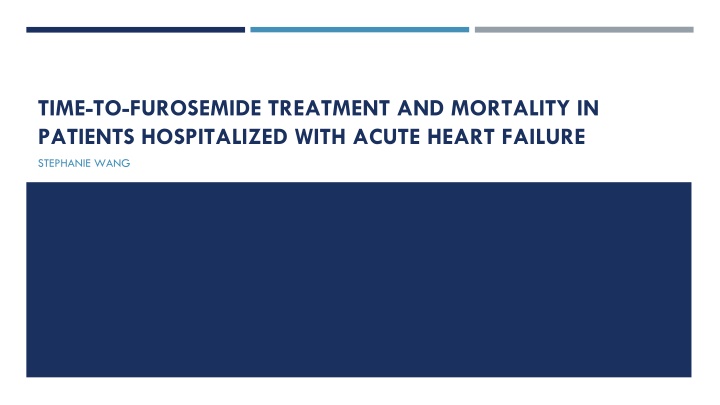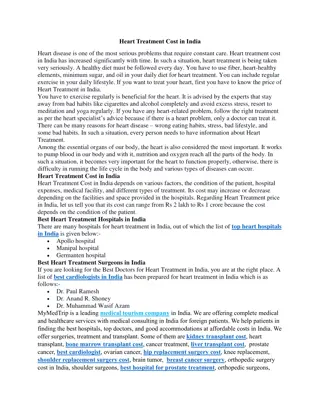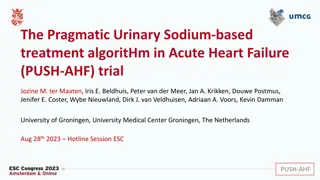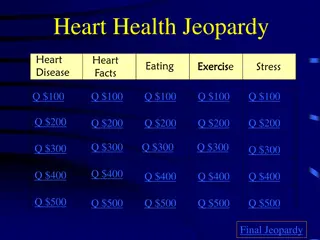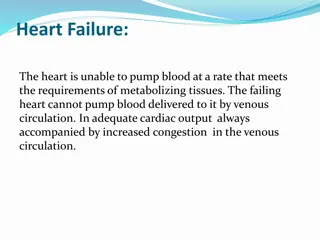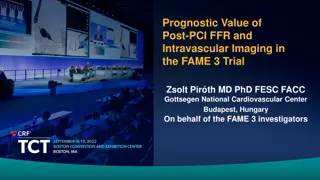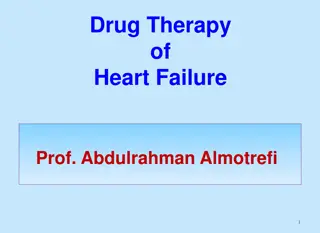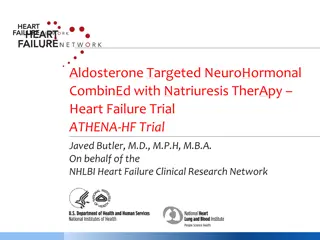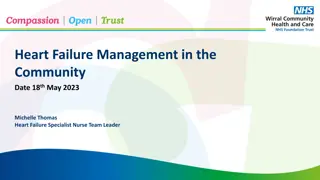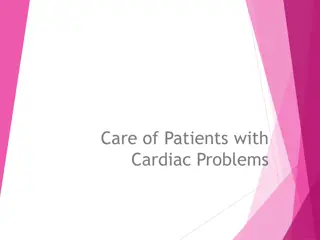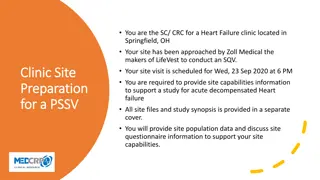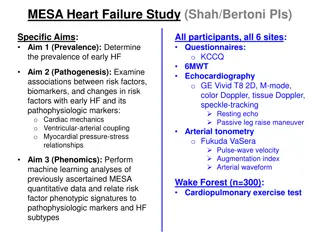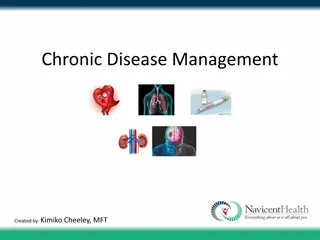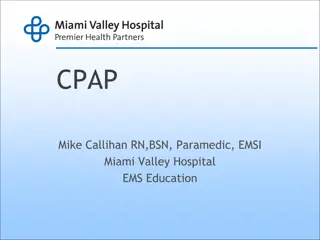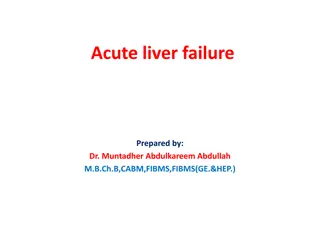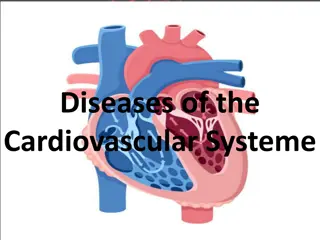Prognostic Impact of Time-to-Furosemide Treatment in Acute Heart Failure Patients
Acute heart failure is a critical public health concern with high morbidity and mortality rates. This study explores the prognostic significance of early furosemide treatment in patients presenting with acute heart failure, shedding light on in-hospital mortality outcomes based on timely intervention. The research methodology, patient population, and primary outcomes of the study are outlined in detail.
Download Presentation

Please find below an Image/Link to download the presentation.
The content on the website is provided AS IS for your information and personal use only. It may not be sold, licensed, or shared on other websites without obtaining consent from the author.If you encounter any issues during the download, it is possible that the publisher has removed the file from their server.
You are allowed to download the files provided on this website for personal or commercial use, subject to the condition that they are used lawfully. All files are the property of their respective owners.
The content on the website is provided AS IS for your information and personal use only. It may not be sold, licensed, or shared on other websites without obtaining consent from the author.
E N D
Presentation Transcript
TIME-TO-FUROSEMIDE TREATMENT AND MORTALITY IN PATIENTS HOSPITALIZED WITH ACUTE HEART FAILURE STEPHANIE WANG
BACKGROUND Acute heart failure is an important public health issue with high morbidity, mortality rates and a high economic burden In the US, ~1 million ED visits for acute heart failure per year and >80% are admitted Prevalence of HF in the US projected to rise over the next 4 decades with an estimated 772,000 new HF cases projected in the year 2040 Management has not changed for decades ADHERE trial - authors demonstrated that in-hospital mortality increased by 2.1% per every 4h of delay in the time to first IV furosemide.
CLINICAL QUESTION What is the prognostic impact of time-to-furosemide treatment in patients who present in acute heart failure?
DESIGN REALITY-AHF (Registry focused on Very Early Presentation and Treatment in Emergency Department of Acute Heart Failure) Prospective, multicenter, observational cohort study Setting: ED of 20 participating hospitals (9 university, 11 non university hospitals) throughout Japan Door-to-furosemide time in the ED Early treatment: within 60 minutes Non-early treatment: >60 minutes Registered N = 1,762 patients Primary outcome: All-cause in-hospital mortality
POPULATION Inclusion Criteria >20 yrs of age Diagnosed with AHF within 3 hours of first evaluation Exclusion Criteria Treated in pre-hospital phase - any IV medications given Hx heart transplantation HD Acute myocarditis ACS BNP<100 or missing BNP data Received furosemide >24hrs after arrival in the ED
METHODS All enrollment through the ED -Time of arrival recorded -Patients followed for 48 hrs from time of arrival -Outpatient HF medication doses and timing recorded as well as all inpatient medication dosing and timing -Echo performed and patients categorized into 3 groups: EF<35%; 35% - 50%; >50%. Diagnosis of AHF made based on Framingham criteria Opt-out method for participation Assessment of mortality risk - GWTG-HF risk score Univariate and multivariable logistic regression analysis were performed to evaluate association between early treatment and in-hospital prognosis 6
DISCUSSION QUESTIONS Is this an appropriate design? Are the inclusion and exclusion criteria reasonable? Do you agree with the primary outcome? Should secondary outcomes have been evaluated? 7
RESULTS 8
RESULTS Mortality rate: 11 patients (2.3%) in the early treatment group and 49 (6%) in the non-early treatment group (p=0.002) Median D2F time was 90 min and 481 patients (37.3%) were categorized as the early treatment group. Mortality rate increased as GWTG-HF risk score increased in both groups (p for trend <0.05 for both groups) A lower mortality rate in the early treatment group compared with that for the non-early treatment group despite initial mortality risk The benefit of early D2F time and mortality is even greater in high risk groups
RESULTS Nonlinear relationship of D2F time and mortality First few hours after ED arrival, mortality steeply increased as D2F time was delayed, but effect leveled off after approximately 100 min 12
DISCUSSION Early treatment of acute heart failure with loop diuretics lowers mortality despite initial mortality risk, and this treatment strategy might be even more effective in high-risk AHF patients Earlier treatment/identification of acute heart failure relied heavily on classic symptoms/signs suggestive of congestion Orthopnea Elevated JVP Peripheral edema Rales Pulmonary edema
DISCUSSION QUESTIONS What criticisms of the study do you have? Do the study results change your clinical practice? 14
CRITICISMS/ADDITIONAL QUESTIONS No cardiac enzyme values No comment on total IV diuretic use Acute cause of HF not reported Secondary outcomes not evaluated - length of hospital stay, other complications Follow-up time All done in Japan What is the pathophysiology behind importance of D2F time? What is the optimal D2F time?
BOTTOM LINE Diurese ASAP, reassess for response Keep in mind that even patients who appear well require prompt diuresis
MKSAP QUESTION #1 A 40 year old woman is evaluate for 2 months of progressive dyspnea on exertion, orthopnea, and lower extremity edea. She has no other medical problems and takes no medications, including over-the-counter drugs, and she does use illicit drugs. She does not smoke cigarettes and rarely drinks alcohol. There is no family history of heart disease. QUESTION: Which of the following is the most appropriate initial diagnostic test? B-type natriuretic peptide level echocardiography radionuclide ventriculography stress test On physical examination, she is afebrile. Blood pressure is 120/80 and pulse is 80/min. Estimated CVP is 8cm. Lungs are clear. Cardiac examination reveals a regular rhythm, an S3, and no murmurs. There is mild ankle edema. Chest radiograph shows mild vascular congestion. Electrocardiogram shows normal sinus rhythm. Initial laboratory study reveals normal hemoglobin, metabolic profile, and thyroid studies. A. B. C. D.
MKSAP QUESTION #2 A 60 yo white women is evaluated for dyspnea with mild activity (ascending less than 1 flight of stairs, walking less than one block on level ground) that has been stable for the past year. She has a history of nonischemic cardiomyopathy (EF 20%). Current medications include lisinopril, carvedilol, digoxin, and furosemide. She had an ICD placed 1 yr ago. QUESTION: Which of the following is the most appropriate addition to her treatment? Angiotensin receptor blocker Hydralazine Metolazone Spironolactone A. On exam, she is afebrile, BP 95/75, pulse 70. Jugular veins are not distended, and the lungs are clear. Cardiac examination discloses a regular rate and rhythm, no murmurs, normal S1 and S2, and no S3. There is no edema. Labs show serum K levels of 4.7mEq/L and creatinine of 1.8mg/dL which is stable. B. C. D. 18
Class IA: aldosterone receptor antagonist recommended in patients with NYHA II-IV and an EF <35% to reduce morbidity/mortality What are some contraindications to starting spironolactone? 20
REFERENCES Yancy, Clyde W., et al. 2013 ACCF/AHA Guideline for the Management of Heart Failure: Executive Summary. Journal of the American College of Cardiology, vol. 62, no. 16, 2013, pp. 1495 1539., doi:10.1016/j.jacc.2013.05.020. Matsue, Yuya. Time-to-Furosemide Treatment and Mortality in Patients Hospitalized with Acute Heart Failure, Journal of the American College of Cardiology, 27 June 2017, pp. 3042 3051
